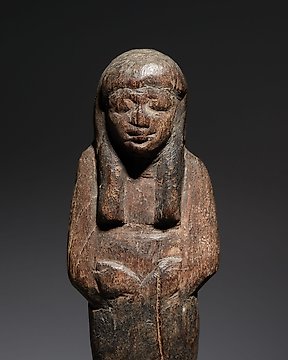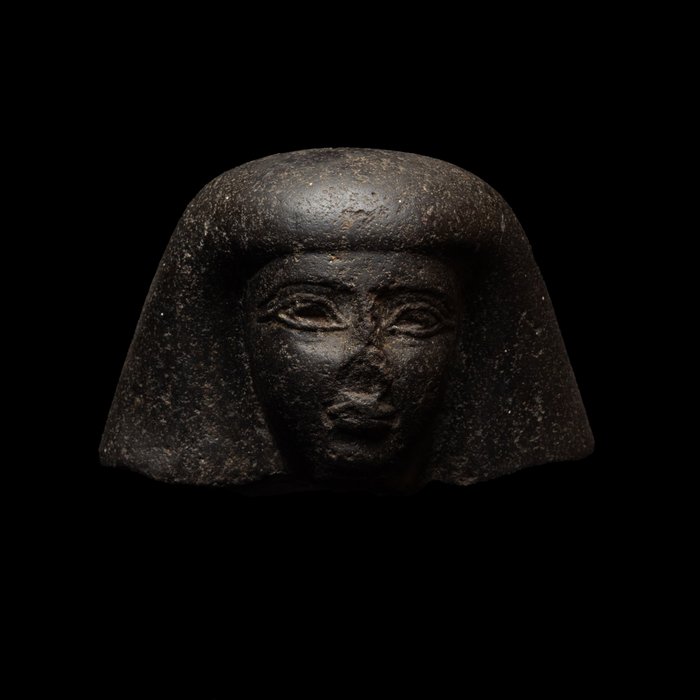
Antigo Egito, Pré-dinástico Madeira Ushebti. Novo Reino 1550-1070 AC. 22 cm.
N.º 83491325

N.º 83491325

Head of a Dignitary.
Ancient Egypt, New Empire, 1550 - 1070 B.C.
Granodiorite.
11 cm length and 7.5 cm height.
Condition: Good condition. It has a notch on the nose.
Provenance:
- Private collection, Rober Kime, from the contents of his house in Warwick Square, London, United Kingdom. 1970 - 1980.
- Private collection, Barcelona, Spain.
Head of a sculpture representing an Egyptian dignitary, carved in a round shape. It can be deduced that it is the image of a high-ranking personage, probably a nobleman, given that, although it is a small size carving, it is made of a particularly expensive material such as granodiorite, a rock characterized by its hardness and, therefore, Therefore, much more difficult to work than limestone, more affordable and also more abundant in Egypt. In the history of Egyptian art, there are great masterpieces carved in limestone and other less rare and expensive stones, such as sandstone, but the hard rocks allowed for much finer polishing, precisely because of their greater density.
The face, with idealized features, shows a triangular profile with a soft chin and rounded jaws. The eyes stand out for their size and the way they are worked, with the silhouette of the profile in kohl worked in relief, as well as the fine eyebrows, straight and gently inclined towards the temples. Now lost, the nose would be triangular, narrow at the top and noticeably wider towards the base. The mouth is carved in great relief, with well-defined full lips and gently recessed corners. The character wears a wig that hides his ears; Flared in shape, wide and short, it appears covered by a simple textile headdress. A similar type of headdress, although open at the front to show the braids of the wig and the earlobes, is represented in great detail on an officer's head found in Thebes (fig. 1).
It is a funerary-type sculpture, made for the tomb of the person it represents, and it would probably be of the seated type common in the New Kingdom, with the figure on a throne that houses hieroglyphic inscriptions (fig. 2).
For the ancient Egyptians, everything represented, whether through round sculptures or parietal reliefs, came to life. That is why everyone who could afford it included representations of themselves in their tomb - in accordance with the ideal and non-portrait style typical of the language of ancient Egypt - whether they were images on the walls or sculptures. These images perpetuated his physical integrity and identity so that, even if his body disappeared, the deceased would continue living in the Afterlife. The free spaces on the surfaces of the sculptures, such as the thrones, dorsal pillars and bases, were used to engrave inscriptions where the name of the deceased and owner of the tomb was mentioned, as well as their titles, along with a series of magical funeral formulas. and offering formulas. The latter were necessary to be able to continue receiving food offerings throughout eternity. These sculptures of the deceased also served as temporary accommodation for his spirit in case of need.
BIBLIOGRAPHY:
- FREED, R. Egypt's Golden Age: The Art of Living in the New Kingdom. 1558-1085 B.C. Boston Museum of Fine Arts. 1982.
- GRAJETZKI, W. Burial Customs in Ancient Egypt: Life and Death for the Rich and Poor. Bristol Classical Press. 2003.
- HAYES, W.C. The Scepter of Egypt II: The Hyksos Period and the New Kingdom (1675-1080 B.C.). The Metropolitan Museum of Art. 1978.
Notes:
- The piece includes authenticity certificate.
- The piece includes Spanish Export License (Passport for European Union) - If the piece is destined outside the European Union a substitution of the export permit should be requested, can take between 1-2 weeks maximum.
- The seller guarantees that he acquired this piece according to all national and international laws related to the ownership of cultural property. Provenance statement seen by Catawiki.
Como comprar na Catawiki
1. Descubra algo especial
2. Faça a licitação vencedora
3. Faça um pagamento seguro